Quantifying the Contribution of Driving Factors on Distribution and Change of Net Primary Productivity of Vegetation in the Mongolian Plateau
Abstract
:1. Introduction
2. Study Area and Materials
2.1. Study Area
2.2. Data Sources and Preprocessing
2.2.1. Topographic Dataset
2.2.2. MODIS Datasets
2.2.3. Reanalysis Dataset
2.2.4. Breathing Earth System Simulator Solar Radiation
2.2.5. Vegetation Type
2.2.6. Soil Type
3. Methods
3.1. Data Preprocessing
3.2. Modified CASA Model
3.3. Theil–Sen Trend and Mann–Kendall Test
3.4. GDM
3.5. SEM
4. Results
4.1. Spatial Distribution of Vegetation NPP in the MP
4.2. Spatiotemporal Variations of NPP in the MP
4.3. Main Factors Affecting NPP’s Spatial Pattern
4.4. Spatio-Temporal Variations of Different Driving Factors
4.5. Pathway Analysis of the Impact of Driving Factors on NPP Changes
5. Discussion
5.1. Interpretation of the Spatial Distribution Characteristics of the MP’s Vegetation NPP
5.2. Effect Pathways of Different Driving Factors on NPP Changes
6. Conclusions
- (1)
- NPP’s spatial distribution in the MP during the growing season showed a decreasing trend from the northeast to the southwest. For different vegetation types covered by this study, NPP ranked as follows: broad-leaved forest > meadow steppe > coniferous forest > cropland > shrub > typical steppe > sandy land > alpine steppe > desert steppe.
- (2)
- The NPP during the growing season showed an increasing trend in different vegetation types, with significant variations in NPP for different vegetation types except for desert steppe and broad-leaved forest. In addition to providing larger vegetation carbon stocks, forest ecosystems also maintain more stable productivity levels.
- (3)
- Vegetation cover, moisture condition, and solar radiation were the dominant factors in NPP’s spatial distribution, followed by temperature and topographic elements. These factors contributed to the spatial distribution of NPP in descending order of explanation: the NDVI (0.86), solar radiation (0.71), precipitation (0.67), vegetation type (0.67), soil moisture (0.57), soil type (0.57), temperature (0.26), elevation (0.19), slope (0.11), and aspect (0.006).
- (4)
- The SEM constructed for this study explained 17% to 65% of the NPP variations, and the NPP change was dominated by the direct effects of the NDVI and moisture condition (precipitation and soil moisture). The total effects of NPP variations in the MP in absolute value were as follows: NDVI (0.47) > precipitation (0.33) > soil moisture (0.16) > temperature (0.14) > solar radiation (0.02). The effects of the NDVI and climate change on NPP varied by different vegetation types, with soil moisture being the dominant moisture factor for steppes and forests in determining NPP variations, while precipitation was the dominant moisture factor in sandy land, shrub, and cropland. Additionally, NPP variations were less influenced by the temperature variations for different vegetation types.
Supplementary Materials
Author Contributions
Funding
Data Availability Statement
Conflicts of Interest
References
- Luo, M.; Sa, C.; Meng, F.; Duan, Y.; Liu, T. Assessing extreme climatic changes on a monthly scale and their implications for vegetation in Central Asia. J. Clean. Prod. 2020, 271, 122396. [Google Scholar] [CrossRef]
- Xu, L.; Yu, G.; He, N.; Wang, Q.; Gao, Y.; Wen, D.; Li, S.; Niu, S.; Ge, J. Carbon storage in China’s terrestrial ecosystems: A synthesis. Sci. Rep. 2018, 8, 2806. [Google Scholar] [CrossRef] [PubMed] [Green Version]
- Minshu, Y.; Qiuan, Z.; Jiang, Z.; Jinxun, L.; Huai, C.; Changhui, P.; Peng, L.; Mingxu, L.; Meng, W.; Pengxiang, Z. Global response of terrestrial gross primary productivity to climate extremes. Sci. Total Environ. 2021, 750, 142337–142350. [Google Scholar]
- Du, L.; Gong, F.; Zeng, Y.; Ma, L.; Qiao, C.; Wu, H. Carbon use efficiency of terrestrial ecosystems in desert/grassland biome transition zone: A case in Ningxia province, northwest China. Ecol. Indic. 2021, 120, 106971–106981. [Google Scholar] [CrossRef]
- Teng, M.; Zeng, L.; Hu, W.; Wang, P.; Yan, Z.; He, W.; Zhang, Y.; Huang, Z.; Xiao, W. The impacts of climate changes and human activities on net primary productivity vary across an ecotone zone in Northwest China. Sci. Total Environ. 2020, 714, 136691. [Google Scholar] [CrossRef]
- Liu, H.; Jia, J.; Lin, Z.; Wang, Z.; Gong, H. Relationship between net primary production and climate change in different vegetation zones based on EEMD detrending—A case study of Northwest China. Ecol. Indic. 2021, 122, 107276. [Google Scholar] [CrossRef]
- Gu, X.; Zhao, H.; Peng, C.; Guo, X.; Lin, Q.; Yang, Q.; Chen, L. The mangrove blue carbon sink potential: Evidence from three net primary production assessment methods. For. Ecol. Manag. 2022, 504, 119848. [Google Scholar] [CrossRef]
- Chi, C.; Taejin, P.; Xuhui, W.; Shilong, P.; Baodong, X.; Chaturvedi, R.K.; Richard, F.; Victor, B.; Philippe, C.; Rasmus, F.; et al. China and India lead in greening of the world through land-use management. Nat. Sustain. 2019, 2, 122–129. [Google Scholar]
- Yang, L.; Shen, F.; Zhang, L.; Cai, Y.; Yi, F.; Zhou, C. Quantifying influences of natural and anthropogenic factors on vegetation changes using structural equation modeling: A case study in Jiangsu Province, China. J. Clean. Prod. 2021, 280, 124330. [Google Scholar] [CrossRef]
- Yin, L.; Dai, E.; Zheng, D.; Wang, Y.; Ma, L.; Tong, M. What drives the vegetation dynamics in the Hengduan Mountain region, southwest China: Climate change or human activity? Ecol. Indic. 2020, 112, 106013–106024. [Google Scholar] [CrossRef]
- Sun, Q.; Li, B.; Zhou, C.; Li, F.; Zhang, Z.; Ding, L.; Zhang, T.; Xu, L. A systematic review of research studies on the estimation of net primary productivity in the Three-River Headwater Region, China. J. Geog. Sci. 2017, 27, 161–182. [Google Scholar] [CrossRef]
- Sun, H.; Chen, Y.; Xiong, J.; Ye, C.; Yong, Z.; Wang, Y.; He, D.; Xu, S. Relationships between climate change, phenology, edaphic factors, and net primary productivity across the Tibetan Plateau. Int. J. Appl. Earth Obs. Geoinf. 2022, 107, 102708–102718. [Google Scholar] [CrossRef]
- Liu, Y.; Yang, Y.; Wang, Q.; Muhammad, K.; Zhang, Z.; Tong, L.; Jianlong, L.I.; Shi, A. Assessing the Dynamics of Grassland Net Primary Productivity in Response to Climate Change at the Global Scale. Chin. Geogr. Sci. 2019, 29, 725–740. [Google Scholar] [CrossRef] [Green Version]
- Bao, G.; Chen, J.; Chopping, M.; Bao, Y.; Bayarsaikhan, S.; Dorjsuren, A.; Tuya, A.; Jirigala, B.; Qin, Z. Dynamics of net primary productivity on the Mongolian Plateau: Joint regulations of phenology and drought. Int. J. Appl. Earth Obs. Geoinf. 2019, 81, 85–97. [Google Scholar] [CrossRef]
- Guo, D.; Song, X.; Hu, R.; Cai, S.; Zhu, X.; Hao, Y. Grassland type-dependent spatiotemporal characteristics of productivity in Inner Mongolia and its response to climate factors. Sci. Total Environ. 2021, 775, 145644. [Google Scholar] [CrossRef]
- Luo, Z.; Wu, W.; Yu, X.; Song, Q.; Yang, J.; Wu, J.; Zhang, H. Variation of Net Primary Production and Its Correlation with Climate Change and Anthropogenic Activities over the Tibetan Plateau. Remote Sens. 2018, 10, 1352. [Google Scholar] [CrossRef]
- Bao, G.; Bao, Y.; Qin, Z.; Xin, X.; Bao, Y.; Bayarsaikan, S.; Zhou, Y.; Chuntai, B. Modeling net primary productivity of terrestrial ecosystems in the semi-arid climate of the Mongolian Plateau using LSWI-based CASA ecosystem model. Int. J. Appl. Earth Obs. Geoinf. 2016, 46, 84–93. [Google Scholar] [CrossRef]
- Lei, T.; Feng, J.; Lv, J.; Wang, J.; Song, H.; Song, W.; Gao, X. Net Primary Productivity Loss under different drought levels in different grassland ecosystems. J. Environ. Manag. 2020, 274, 111144–111155. [Google Scholar] [CrossRef]
- Wang, J.F.; Li, X.H.; Christakos, G.; Liao, Y.L.; Zhang, T.; Gu, X.; Zheng, X.Y. Geographical Detectors-Based Health Risk Assessment and its Application in the Neural Tube Defects Study of the Heshun Region, China. Int. J. Geog. Inf. Sci. 2010, 24, 107–127. [Google Scholar] [CrossRef]
- Kang, Y.; Guo, E.; Wang, Y.; Bao, Y.; Bao, Y.; Mandula, N. Monitoring Vegetation Change and Its Potential Drivers in Inner Mongolia from 2000 to 2019. Remote Sens. 2021, 13, 3357. [Google Scholar] [CrossRef]
- Huo, H.; Sun, C. Spatiotemporal variation and influencing factors of vegetation dynamics based on Geodetector: A case study of the northwestern Yunnan Plateau, China. Ecol. Indic. 2021, 130, 108005–108014. [Google Scholar] [CrossRef]
- Guo, B.; Han, B.; Yang, F.; Chen, S.; Liu, Y.; Yang, W. Determining the contributions of climate change and human activities to the vegetation NPP dynamics in the Qinghai-Tibet Plateau, China, from 2000 to 2015. Environ. Monit. Assess. 2020, 192, 663–680. [Google Scholar] [CrossRef] [PubMed]
- Bao, G.; Tuya, A.; Bayarsaikhan, S.; Dorjsuren, A.; Mandakh, U.; Bao, Y.; Li, C.; Vanchindorj, B. Variations and climate constraints of terrestrial net primary productivity over Mongolia. Quat. Int. 2020, 537, 112–125. [Google Scholar] [CrossRef]
- Dong, G.; Zhao, F.; Chen, J.; Zhang, Y.; Shao, C. Non-climatic component provoked substantial spatiotemporal changes of carbon and water use efficiency on the Mongolian Plateau. Environ. Res. Lett. 2020, 15, 095009. [Google Scholar] [CrossRef]
- Guo, E.; Wang, Y.; Wang, C.; Sun, Z.; Bao, Y.; Mandula, N.; Jirigala, B.; Bao, Y.; Li, H. NDVI Indicates Long-Term Dynamics of Vegetation and Its Driving Forces from Climatic and Anthropogenic Factors in Mongolian Plateau. Remote Sens. 2021, 13, 688. [Google Scholar] [CrossRef]
- Luo, M.; Meng, F.; Sa, C.; Duan, Y.; Bao, Y.; Liu, T.; De Maeyer, P. Response of vegetation phenology to soil moisture dynamics in the Mongolian Plateau. Catena 2021, 206, 105505. [Google Scholar] [CrossRef]
- Zhang, R.; Zhao, X.; Zuo, X.; Degen, A.A.; Li, Y.; Liu, X.; Luo, Y.; Qu, H.; Lian, J.; Wang, R. Drought-induced shift from a carbon sink to a carbon source in the grasslands of Inner Mongolia, China. Catena 2020, 195, 104845–104855. [Google Scholar] [CrossRef]
- Liu, Y.; Yang, P.; Zhang, Z.; Zhang, W.; Wang, Z.; Zhang, Z.; Ren, H.; Zhou, R.; Wen, Z.; Hu, T. Diverse responses of grassland dynamics to climatic and anthropogenic factors across the different time scale in China. Ecol. Indic. 2021, 132, 108341. [Google Scholar] [CrossRef]
- Wang, J.; Brown, D.G.; Chen, J. Drivers of the dynamics in net primary productivity across ecological zones on the Mongolian Plateau. Landsc. Ecol. 2013, 28, 725–739. [Google Scholar] [CrossRef]
- Meng, F.; Luo, M.; Sa, C.; Wang, M.; Bao, Y. Quantitative assessment of the effects of climate, vegetation, soil and groundwater on soil moisture spatiotemporal variability in the Mongolian Plateau. Sci. Total Environ. 2022, 809, 152198. [Google Scholar] [CrossRef]
- Ryu, Y.; Jiang, C.; Kobayashi, H.; Detto, M. MODIS-derived global land products of shortwave radiation and diffuse and total photosynthetically active radiation at 5km resolution from 2000. Remote Sens. Environ. Interdiscip. J. 2018, 204, 812–825. [Google Scholar] [CrossRef]
- PZ, S.; KV, J. Comparative study of innovative trend analysis technique with Mann-Kendall tests for extreme rainfall. Arab. J. Geosci. 2021, 14, 536–550. [Google Scholar]
- Fan, Y.; Chen, J.; Shirkey, G.; John, R.; Wu, S.R.; Park, H.; Shao, C. Applications of structural equation modeling (SEM) in ecological studies: An updated review. Ecol. Process. 2016, 5, 19. [Google Scholar] [CrossRef] [Green Version]
- Kline, R.B. Principles and Practice of Structural Equation Modeling; The Guilford Press: New York, NY, USA, 2022. [Google Scholar]
- Li, Y.; Bao, W.; Bongers, F.; Chen, B.; Chen, G.; Guo, K.; Jiang, M.; Lai, J.; Lin, D.; Liu, C.; et al. Drivers of tree carbon storage in subtropical forests. Sci. Total Environ. 2019, 654, 684–693. [Google Scholar] [CrossRef]
- Gu, Z.; Zhang, Z.; Yang, J.; Wang, L. Quantifying the Influences of Driving Factors on Vegetation EVI Changes Using Structural Equation Model: A Case Study in Anhui Province, China. Remote Sens. 2022, 14, 4203. [Google Scholar] [CrossRef]
- Steeger, C.M.; Gondoli, D.M. Mother-adolescent conflict as a mediator between adolescent problem behaviors and maternal psychological control. Dev. Psychol. 2013, 49, 804–814. [Google Scholar] [CrossRef] [Green Version]
- Schönbach, P.; Wan, H.; Gierus, M.; Bai, Y.; Müller, K.; Lin, L.; Susenbeth, A.; Taube, F. Grassland responses to grazing: Effects of grazing intensity and management system in an Inner Mongolian steppe ecosystem. Plant Soil 2010, 340, 103–115. [Google Scholar] [CrossRef]
- Yang, S.; Bai, Y.; Alatalo, J.M.; Wang, H.; Tong, J.; Liu, G.; Zhang, F.; Chen, J. Spatial–temporal pattern of cultivated land productivity based on net primary productivity and analysis of influencing factors in the Songhua River basin. Land Degrad. Dev. 2022, 33, 1917–1932. [Google Scholar] [CrossRef]
- Li, S.; He, S. The variation of net primary productivity and underlying mechanisms vary under different drought stress in Central Asia from 1990 to 2020. Agric. For. Meteorol. 2022, 314, 108767. [Google Scholar] [CrossRef]
- Li, W.; Migliavacca, M.; Forkel, M.; Denissen, J.M.C.; Reichstein, M.; Yang, H.; Duveiller, G.; Weber, U.; Orth, R. Widespread increasing vegetation sensitivity to soil moisture. Nat. Commun. 2022, 13, 3959–3967. [Google Scholar] [CrossRef]
- Sun, Y.; Yang, Y.; Zhao, X.; Tang, Z.; Wang, S.; Fang, J. Global patterns and climatic drivers of above- and belowground net primary productivity in grasslands. Sci. China Life Sci. 2021, 64, 739–751. [Google Scholar] [CrossRef] [PubMed]
- Zhu, L.; Meng, J.; Zhu, L. Applying Geodetector to disentangle the contributions of natural and anthropogenic factors to NDVI variations in the middle reaches of the Heihe River Basin. Ecol. Indic. 2020, 117, 106545–106556. [Google Scholar] [CrossRef]
- Wu, L.; Ma, X.; Dou, X.; Zhu, J.; Zhao, C. Impacts of climate change on vegetation phenology and net primary productivity in arid Central Asia. Sci. Total Environ. 2021, 796, 149055–149069. [Google Scholar] [CrossRef] [PubMed]
- Groisman, P.; Shugart, H.; Kicklighter, D.; Henebry, G.; Tchebakova, N.; Maksyutov, S.; Monier, E.; Gutman, G.; Gulev, S.; Qi, J. Northern Eurasia Future Initiative (NEFI): Facing the challenges and pathways of global change in the twenty-first century. Prog. Earth Planet. Sci. 2017, 4, 41. [Google Scholar] [CrossRef] [Green Version]
- Li, Z.; Chen, Y.; Wang, Y.; Fang, G. Dynamic changes in terrestrial net primary production and their effects on evapotranspiration. Hydrol. Earth Syst. Sci. 2016, 20, 2169–2178. [Google Scholar] [CrossRef] [Green Version]
- Ge, W.; Deng, L.; Wang, F.; Han, J. Quantifying the contributions of human activities and climate change to vegetation net primary productivity dynamics in China from 2001 to 2016. Sci. Total Environ. 2021, 773, 145648–145658. [Google Scholar] [CrossRef]
- Baligar, V.C.; Elson, M.; He, Z.; Li, Y.; Paiva, A.D.Q.; Almeida, A.-A.; Ahnert, D. Light Intensity Effects on the Growth, Physiological and Nutritional Parameters of Tropical Perennial Legume Cover Crops. Agronomy 2020, 10, 1515. [Google Scholar] [CrossRef]
- Shi, Y.; Xu, L.; Zhou, Y.; Ji, B.; Zhou, G.; Fang, H.; Yin, J.; Deng, X. Quantifying driving factors of vegetation carbon stocks of Moso bamboo forests using machine learning algorithm combined with structural equation model. For. Ecol. Manag. 2018, 429, 406–413. [Google Scholar] [CrossRef]
- Chen, Y.; Feng, X.; Tian, H.; Wu, X.; Gao, Z.; Feng, Y.; Piao, S.; Lv, N.; Pan, N.; Fu, B.-J. Accelerated increase in vegetation carbon sequestration in China after 2010: A turning point resulting from climate and human interaction. Glob. Chang. Biol. 2021, 27, 5848–5864. [Google Scholar] [CrossRef]
- MacKinnon, D.; Krull, J.; Lockwood, C. MacKinnon DP, Krull JL, Lockwood CM. Equivalence of the mediation, confounding and suppression effect. Prev. Sci. Off. J. Soc. Prev. Res. 2001, 1, 173–181. [Google Scholar] [CrossRef]
- Yin, C.; Luo, M.; Meng, F.; Sa, C.; Yuan, Z.; Bao, Y. Contributions of Climatic and Anthropogenic Drivers to Net Primary Productivity of Vegetation in the Mongolian Plateau. Remote Sens. 2022, 14, 3383. [Google Scholar] [CrossRef]
- Zhang, Y.; Wang, Q.; Wang, Z.; Yang, Y.; Li, J. Impact of human activities and climate change on the grassland dynamics under different regime policies in the Mongolian Plateau. Sci. Total Environ. 2020, 698, 134304. [Google Scholar] [CrossRef] [PubMed]
- Miao, L.; Sun, Z.; Ren, Y.; Schierhorn, F.; Müller, D. Grassland greening on the Mongolian Plateau despite higher grazing intensity. Land Degrad. Dev. 2020, 32, 792–802. [Google Scholar] [CrossRef]
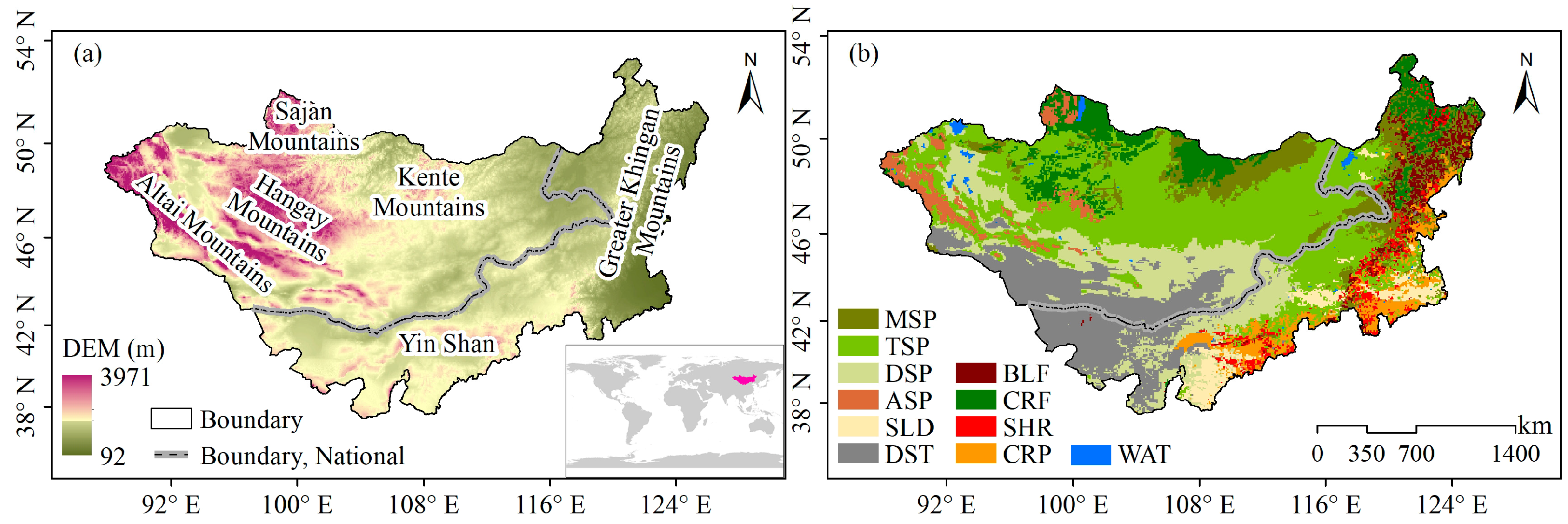
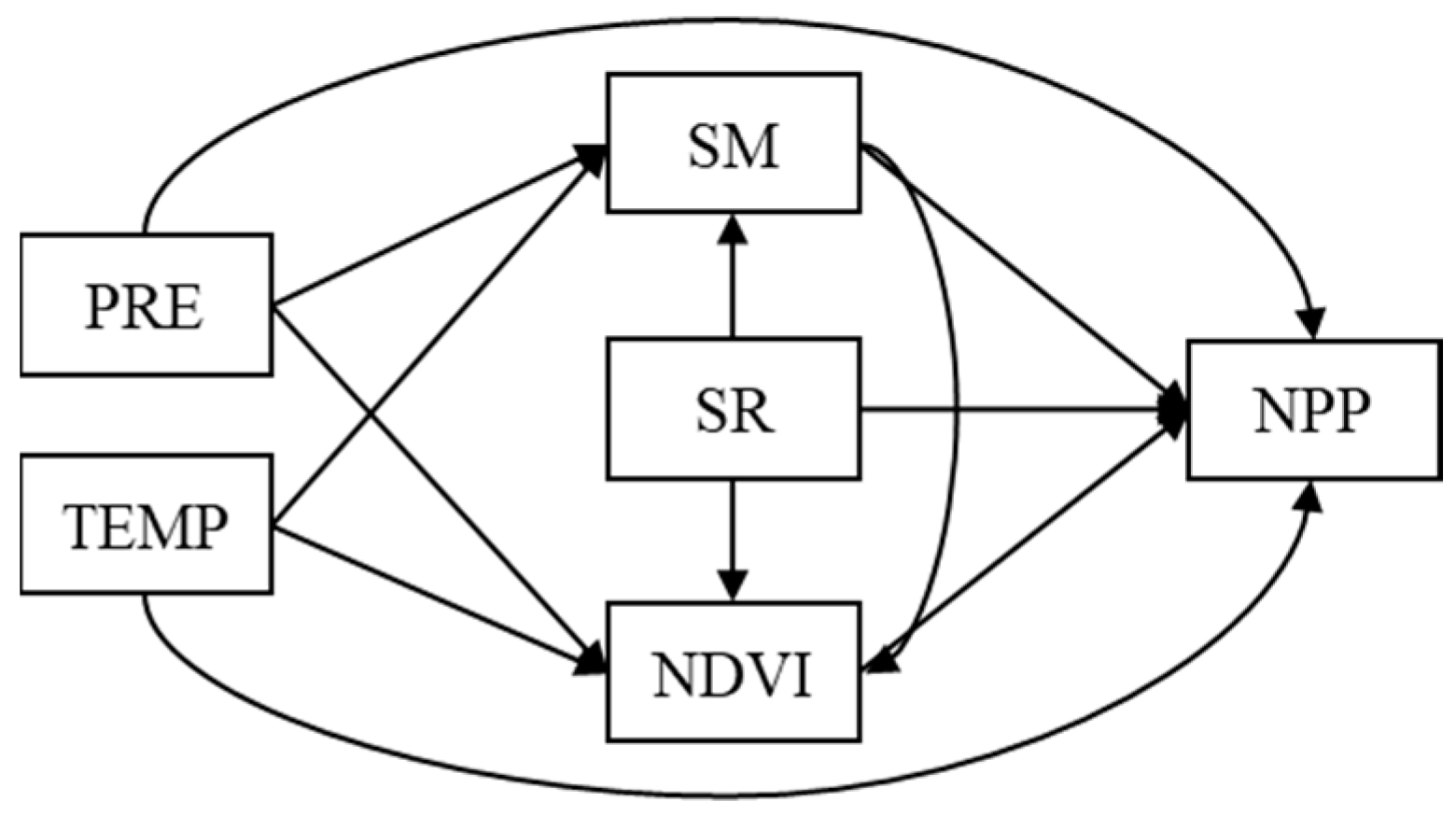


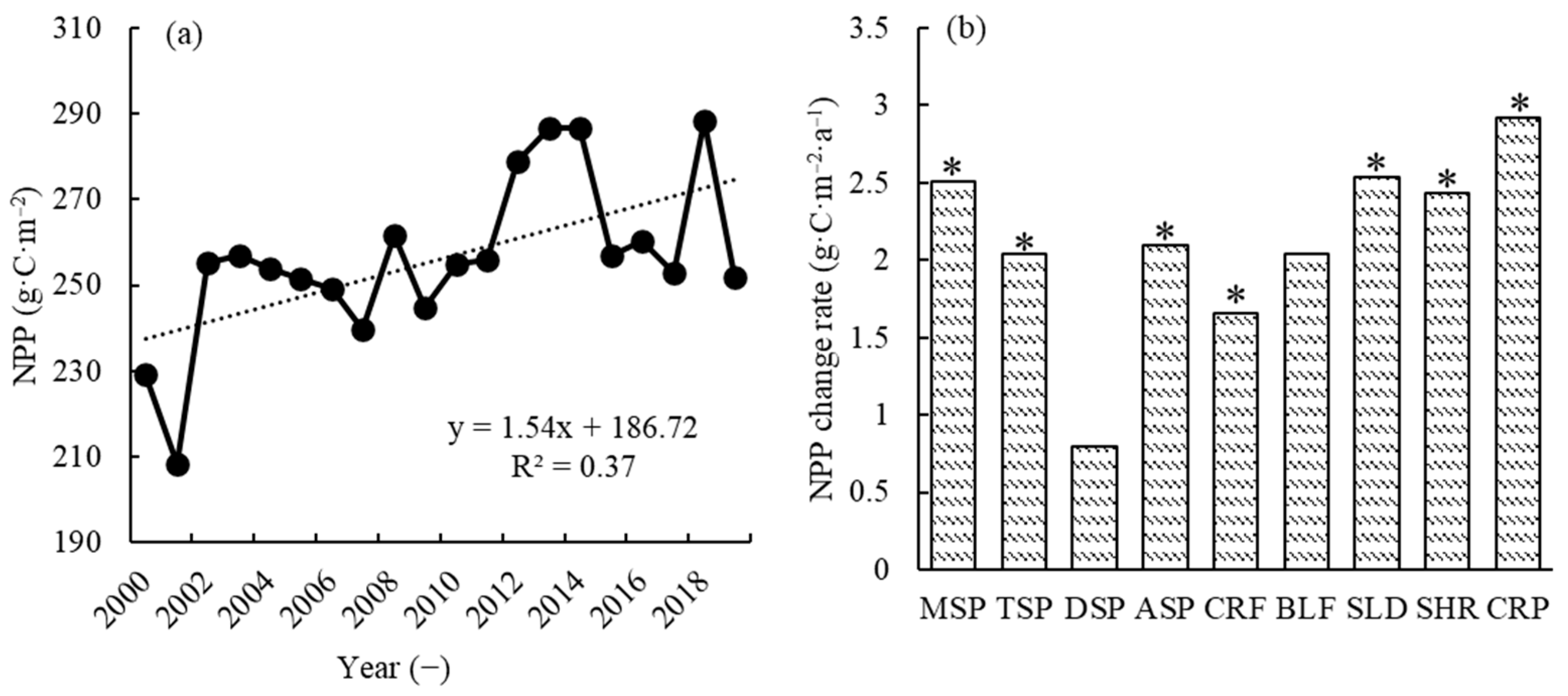

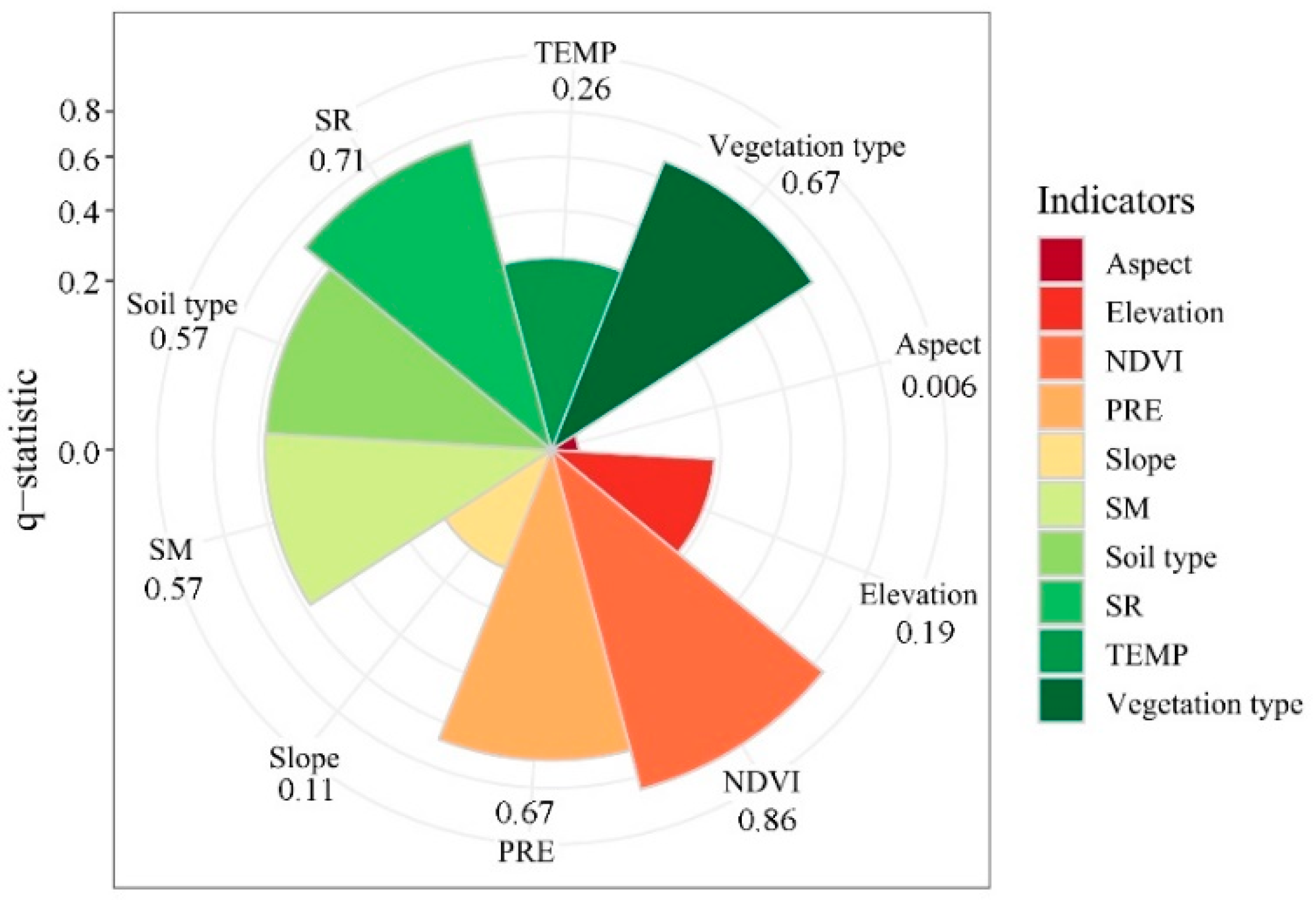

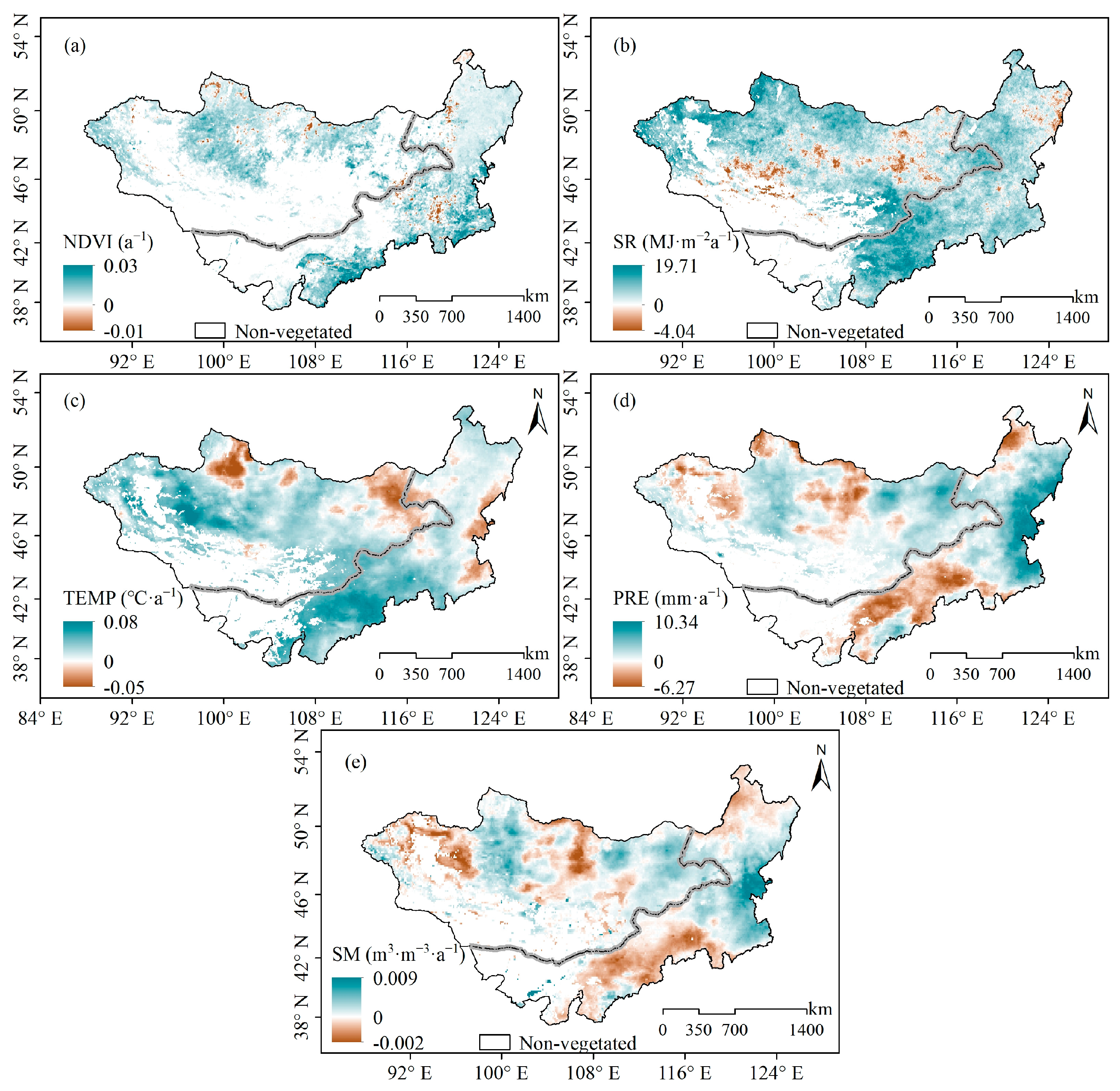
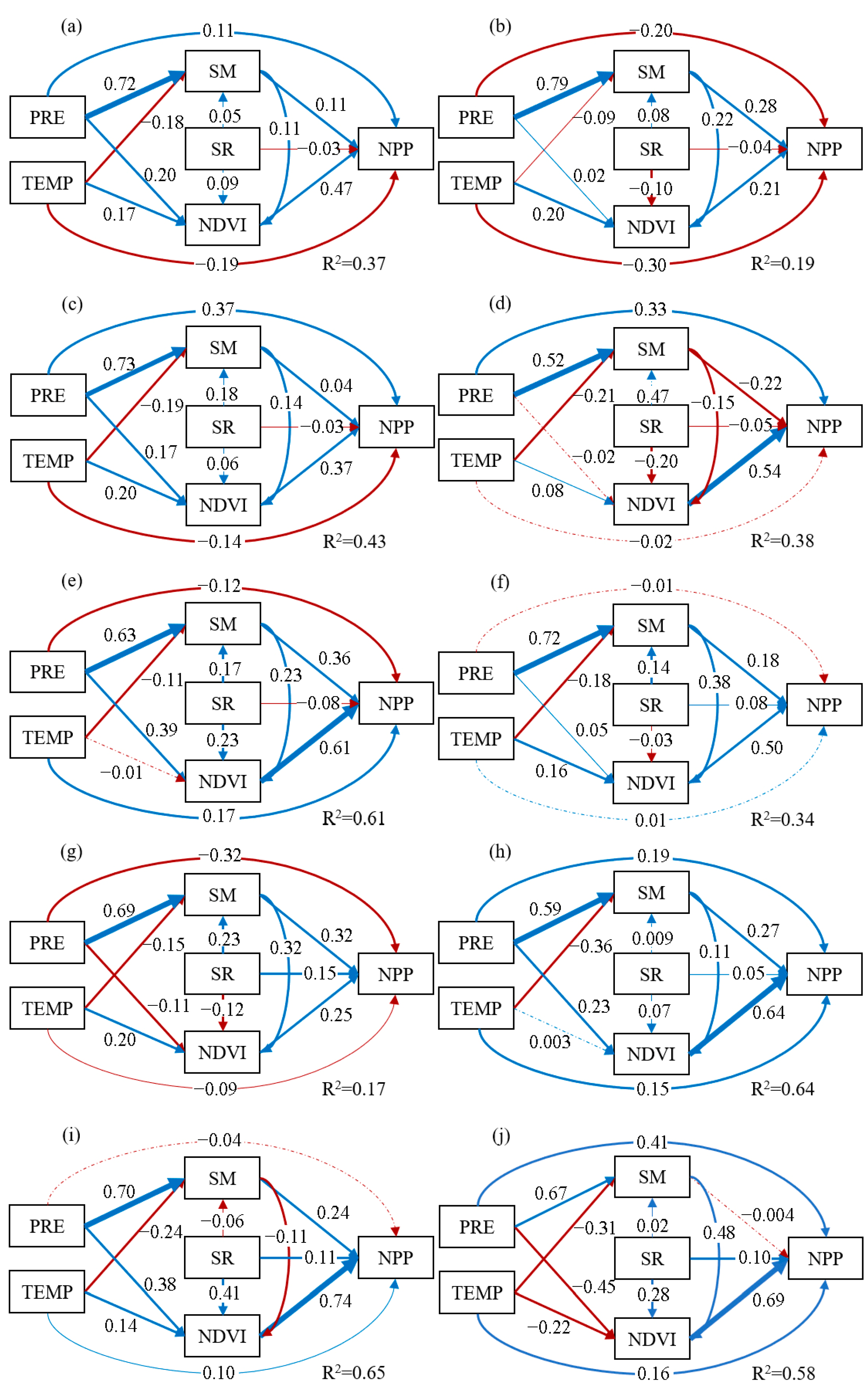
| Data | Temporal Resolution | Spatial Resolution | Period | Dataset Name | Source |
|---|---|---|---|---|---|
| Elevation, slope, and aspect | - | 30 m × 30 m | - | ASTER GDEM | http://Ipdaac.usgs.gov/products/ (accessed on 8 August 2022) |
| NDVI | 16-day | 500 m × 500 m | 2000–2019 | MOD13A1 | https://lpdaacsvc.cr.usgs.gov/appeears/ (accessed on 8 August 2022) |
| NPP | yearly | 500 m × 500 m | 2000–2019 | MOD17A2 | https://lpdaacsvc.cr.usgs.gov/appeears/ (accessed on 8 August 2022) |
| Temperature, precipitation, and soil moisture | daily | 0.1° × 0.1° | 2000–2019 | ERA5-land | https://cds.climate.copernicus.eu/cdsapp#!/search?Type=dataset (accessed on 8 August 2022) |
| Solar radiation | daily | 0.05° × 0.05° | 2000–2019 | BESS | https://www.environment.snu.ac.kr/bess-rad (accessed on 8 August 2022) |
| Vegetation type | - | 500 m × 500 m | 2009 | Vegetation type | National Atlas of Mongolia and 1:1,000,000 Inner Mongolia vegetation map [17] (accessed on 8 August 2022) |
| Soil type | - | 1 km | - | FAO-HWSD | http://www.fao.org/soils-portal/soil-survey/soil-maps-and-databases/harmonized-world-soil-database-v12/en/ (accessed on 8 August 2022) |
| Pathway | MP | MSP | TSP | DSP | ASP | CRF | BLF | SLD | SHR | CRP | |
|---|---|---|---|---|---|---|---|---|---|---|---|
| PRE | PRE → NPP | 0.11 ** | −0.20 ** | 0.37 ** | 0.33 ** | −0.12 ** | −0.01 | −0.32 ** | 0.19 ** | −0.04 | 0.41 ** |
| PRE → NDVI → NPP | 0.09 ** | 0.01 | 0.06 ** | −0.01 | 0.24 ** | 0.02 ** | −0.03 ** | 0.15 ** | 0.28 ** | −0.31 ** | |
| PRE → SM → NPP | 0.08 ** | 0.22 ** | 0.02 ** | −0.11 ** | 0.23 ** | 0.13 ** | 0.22 ** | 0.16 ** | 0.17 ** | 0.00 | |
| PRE → SM → NDVI → NPP | 0.05 ** | 0.05 ** | 0.05 ** | −0.08 ** | 0.14 ** | 0.19 ** | 0.08 ** | 0.07 ** | −0.08 * | 0.33 ** | |
| Total | 0.33 ** | 0.08 ** | 0.50 ** | 0.13 ** | 0.49 ** | 0.33 ** | −0.05 | 0.57 ** | 0.33 ** | 0.43 ** | |
| SR | SR → NPP | −0.03 ** | −0.04 ** | −0.03 ** | −0.05 ** | −0.08 ** | 0.07 ** | 0.15 ** | 0.05 ** | 0.11 ** | 0.10 ** |
| SR → NDVI → NPP | 0.04 ** | −0.02 ** | 0.02 ** | −0.11 ** | 0.09 ** | −0.02 ** | −0.03 ** | 0.04 ** | 0.30 ** | 0.19 ** | |
| SR → SM → NPP | 0.01 ** | 0.02 ** | 0.00 | 0.00 | 0.06 ** | 0.03 ** | 0.07 ** | 0.00 | −0.01 ** | 0.00 | |
| SR → SM → NDVI → NPP | 0.00 ** | 0.00 | 0.00 | 0.00 | 0.02 ** | 0.03 ** | 0.02 ** | 0.00 | 0.01 * | 0.01 ** | |
| Total | 0.02 ** | −0.04 ** | −0.01 | −0.16 ** | 0.09 ** | 0.11 ** | 0.21 ** | 0.09 ** | 0.41 ** | 0.30 ** | |
| TEMP | TEMP → NPP | −0.19 ** | −0.30 ** | −0.14 ** | −0.02 ** | 0.17 ** | 0.01 | −0.09 ** | 0.15 ** | 0.10 ** | 0.16 ** |
| TEMP → NDVI → NPP | 0.08 ** | 0.04 ** | 0.08 ** | 0.04 ** | −0.01 | 0.08 ** | 0.05 ** | 0.00 | 0.10 ** | −0.15 ** | |
| TEMP → SM → NPP | −0.02 ** | −0.02 ** | −0.01 ** | 0.05 ** | −0.04 ** | −0.03 ** | −0.05 ** | −0.10 ** | −0.06 ** | 0.00 | |
| TEMP → SM → NDVI → NPP | −0.01 ** | 0.00 | −0.01 ** | 0.02 ** | −0.02 ** | −0.03 ** | −0.01 ** | −0.03 ** | 0.02 * | −0.10 ** | |
| Total | −0.14 ** | −0.28 ** | −0.08 ** | 0.09 ** | 0.10 ** | 0.03 * | −0.10 ** | 0.02 | 0.16 ** | −0.09 ** | |
| NDVI | NDVI → NPP | 0.47 ** | 0.21 ** | 0.38 ** | 0.54 ** | 0.61 ** | 0.50 ** | 0.25 ** | 0.64 ** | 0.74 ** | 0.69 ** |
| SM | SM → NPP | 0.11 ** | 0.28 ** | 0.04 ** | −0.22 ** | 0.36 ** | 0.18 ** | 0.32 ** | 0.27 ** | 0.24 ** | 0.00 |
| SM → NDVI → NPP | 0.05 ** | 0.05 ** | 0.05 ** | −0.08 ** | 0.14 ** | 0.19 ** | 0.08 ** | 0.07 ** | −0.08 * | 0.33 ** | |
| Total | 0.16 ** | 0.33 ** | 0.09 ** | −0.30 ** | 0.50 ** | 0.37 ** | 0.40 ** | 0.34 ** | 0.16 ** | 0.33 ** |
Disclaimer/Publisher’s Note: The statements, opinions and data contained in all publications are solely those of the individual author(s) and contributor(s) and not of MDPI and/or the editor(s). MDPI and/or the editor(s) disclaim responsibility for any injury to people or property resulting from any ideas, methods, instructions or products referred to in the content. |
© 2023 by the authors. Licensee MDPI, Basel, Switzerland. This article is an open access article distributed under the terms and conditions of the Creative Commons Attribution (CC BY) license (https://creativecommons.org/licenses/by/4.0/).
Share and Cite
Yin, C.; Chen, X.; Luo, M.; Meng, F.; Sa, C.; Bao, S.; Yuan, Z.; Zhang, X.; Bao, Y. Quantifying the Contribution of Driving Factors on Distribution and Change of Net Primary Productivity of Vegetation in the Mongolian Plateau. Remote Sens. 2023, 15, 1986. https://doi.org/10.3390/rs15081986
Yin C, Chen X, Luo M, Meng F, Sa C, Bao S, Yuan Z, Zhang X, Bao Y. Quantifying the Contribution of Driving Factors on Distribution and Change of Net Primary Productivity of Vegetation in the Mongolian Plateau. Remote Sensing. 2023; 15(8):1986. https://doi.org/10.3390/rs15081986
Chicago/Turabian StyleYin, Chaohua, Xiaoqi Chen, Min Luo, Fanhao Meng, Chula Sa, Shanhu Bao, Zhihui Yuan, Xiang Zhang, and Yuhai Bao. 2023. "Quantifying the Contribution of Driving Factors on Distribution and Change of Net Primary Productivity of Vegetation in the Mongolian Plateau" Remote Sensing 15, no. 8: 1986. https://doi.org/10.3390/rs15081986
APA StyleYin, C., Chen, X., Luo, M., Meng, F., Sa, C., Bao, S., Yuan, Z., Zhang, X., & Bao, Y. (2023). Quantifying the Contribution of Driving Factors on Distribution and Change of Net Primary Productivity of Vegetation in the Mongolian Plateau. Remote Sensing, 15(8), 1986. https://doi.org/10.3390/rs15081986








